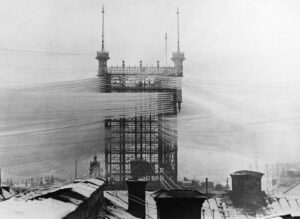
The first cell tower was a bland, steel-lattice tower, raised to the sky; it was ugly and inefficient, with an at-the-time standard of three calls/per the entire city of Chicago.
The cell towers of today, are far more interspersed, be it utilizing an old-fashioned steel and or steel lattice tower design, regular or stealth, or being installed within or atop buildings, churches, and apartment complexes.
Ugly, yet far more efficient this time around, modern, 4G towers are able to support approximately 60 calls without having to redirect them. Today’s article will be a bit of a backtrack, yet an important one, covering the summarized history and evolution of cell towers, from the first to present day.
_________________________________
In 1977, in Chicago, the first prototype cell tower saw its inception, constructed by Ameritech Mobile Communications, now known simply as AT&T. It was crude and was quite ineffectual at the purpose it was meant to serve, but at the time, it allowed for something to occur, that in the past was the stuff of fiction. Calls.
In conjunction with the newest in cell phone technology–that being bulky, immobile telephones, most prominently installed within higher-end cars and on sidewalks, it allowed for people to communicate with other people over a previously untouched medium: Radio Waves.
Similar to visible light, but with a much longer wavelength, Radio Waves allowed us to transmit data capable of passing through most physical objects over great distances, and thus marked the advent of person-to-person communication, not in person.
But as aforementioned, the technology needed lots of tender loving care if it was meant to be something other than a novelty for the upper-class. So companies ran with it. In a conjunctive operation between former-tech giants Bell Labs and Motorola, the Advanced Mobile Phone System (AMPS) was developed and served as the most noteworthy analog mobile phone system in the North Americas, Australia, Asia, and the MIddle East from its nativity on October 13th, 1983, all the way up to mid-2010, seeing its funeral in Brazil.
Now, the nuances of both analog signal and its progeny, digital signal, are far beyond the bounds of this short article to explain, but simplified, they’re merely systems wherein variables are expressed by either a time-varying quantity, such as voltage, currents and pressure, with an infinite range of potential values, such as the former, or discrete, exact values, such as the later, but it is important to realize that the both of these technologies are the foundations with which we were able to build the vast, complex networks we utilize today.
The transition started in the early 2000’s with introduction of more advanced computer technology and it only went from there, but with such advancements required equal work on the part of Tower companies, and that came in the form of using higher frequencies to transmit data faster, because higher frequencies are faster frequencies, but in doing so, vastly diminished the range, which in turn, requires for the construction of more, smaller cell sites to cover societies increasing cellular needs.
This process covers and will cover every generation of data transmission in the near future (1G-5G+), and that thus concludes the abridged, highly summarized history of cell towers.
